
Cannoli are pastries consisting of tube-shaped shells of fried pastry dough, filled with a sweet, creamy filling containing ricotta—a staple of Sicilian cuisine. They range in size from 9 to 20 centimetres. In mainland Italy, they are commonly known as cannoli siciliani.
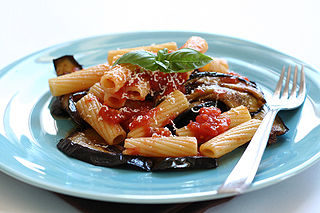
Sicilian cuisine is the style of cooking on the island of Sicily. It shows traces of all cultures that have existed on the island of Sicily over the last two millennia. Although its cuisine has much in common with Italian cuisine, Sicilian food also has Greek, Spanish, French, Jewish, and Arab influences.
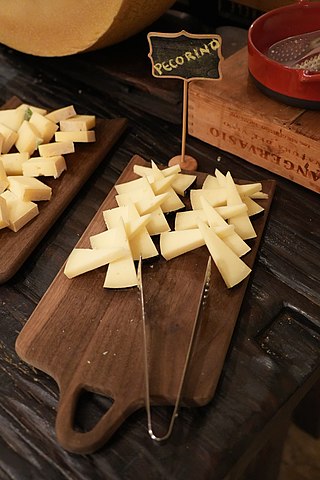
Pecorino is an Italian hard cheese produced from sheep's milk. The name pecorino derives from pecora, which means 'sheep' in Italian.
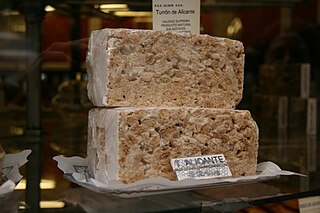
Turrón, torró and torrone is a southwest European and Moroccan nougat confection, typically made of honey, sugar, and egg white, with toasted almonds or other nuts, and usually shaped either into a rectangular tablet or a round cake. Turrón is usually eaten as a dessert food around Christmas in Spain, and Italy. It's also known in Portugal, Morocco, and Latin America.

Sicilian is a Romance language that is spoken on the island of Sicily and its satellite islands. It belongs to the broader Extreme Southern Italian language group.

An empanada is a type of baked or fried turnover consisting of pastry and filling, common in Spain, other Southern European countries, Latin American countries, and the Philippines. The name comes from the Spanish empanar, and translates as 'breaded', that is, wrapped or coated in bread. They are made by folding dough over a filling, which may consist of meat, cheese, tomato, corn, or other ingredients, and then cooking the resulting turnover, either by baking or frying.
"Mafia" is an informal term that is used to describe criminal organizations that bear a strong similarity to the organized crime groups from Italy. The central activity of such an organization would be the arbitration of disputes between criminals as well as the organization and enforcement of illicit agreements between criminals through the use of or threat of violence. Mafias often engage in secondary activities such as gambling, loan sharking, drug-trafficking, prostitution, and fraud.
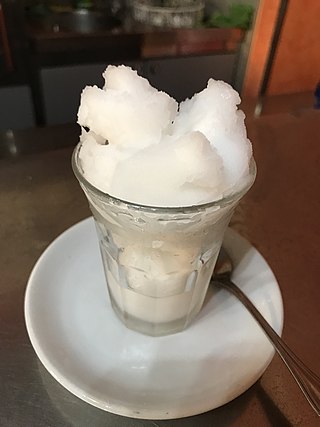
Granita is a semi-frozen dessert made from sugar, water and various flavorings. Originally from Sicily, it is available throughout Italy in varying forms. It is related to sorbet and Italian ice; however, throughout Sicily its consistency varies. Food writer Jeffrey Steingarten says that "the desired texture seems to vary from city to city" on the island; on the west coast and in Palermo, it is at its chunkiest, and in the east, it is nearly as smooth as sorbet. This is largely the result of different freezing techniques: the smoother types are produced in a gelato machine, while the coarser varieties are frozen with only occasional agitation, then scraped or shaved to produce separated crystals. Although its texture varies from coarse to smooth, it is always different from that of ice cream, which is creamier, and from that of sorbet, which is more compact; this makes granita distinct and unique.

Pignolata is a Sicilian pastry, originally from Messina and also common in Calabria. It is a soft pastry, covered in chocolate and lemon-flavoured syrup or icing. This pastry is half covered or iced in one flavouring and the other half in the other flavour, which hardens when the pignolata is ready to be served. Each pastry serves several people, and is meant to be cut into small pieces when served. In Sicily, this dessert was made for Carnival, the last celebration before Lent begins on Ash Wednesday.

Mustacciuoli, also known as mustaccioli or mostaccioli, is a traditional pastry from Naples, Italy, usually served at Christmas time.
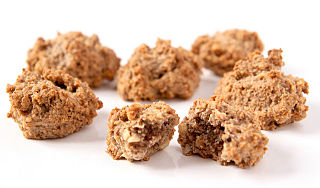
Bruttiboni, also known as mandorlati di San Clemente and brutti ma buoni, is a type of hazelnut or almond-flavoured biscuit made in Prato, Tuscany, and many other cities. These cookies are made by incorporating meringue; an egg white and sugar mixture; with roasted chopped nuts. The cookies are crunchy on the outside with a soft texture in the middle. As with many other Italian cookies, their origin is disputed but they have been made since at least the mid-1800s.

The gelo di melone, also known as gelo d'anguria, is a typical Sicilian dessert, traditionally prepared in Ferragosto. A jellied watermelon pudding, it is also popular for the Saint Rosalia celebrations in Palermo.

The crocetta di Caltanissetta is a traditional Italian sweet pastry that was produced in Caltanissetta, Sicily, until the end of 1908, then forgotten about, and which has recently been rediscovered. The crocetta di Caltanissetta and the spina sacra are two pastry dishes that were traditionally prepared for the feast of the Most Holy Crucifix by the Sisters of the Benedictine Monastery. This monastery was located next to the Church of Santa Croce, from which these sweet pastries take their name.

Pogača is a type of bread baked in the ashes of the fireplace, and later in modern ovens. Found in the cuisines of the Balkans, Levant, and Hungary it can be leavened or unleavened, though the latter is considered more challenging to make. It is generally made from wheat flour, but barley and sometimes rye may be added. It can be stuffed with potatoes, ground beef, olive, or cheese, and have grains and herbs like sesame, black nigella seed, or dried dill in the dough or sprinkled on top.

Cupeta or copeta is a dessert made from honey, dissolved sugar and diced almonds.
Corrado Assenza is a Sicilian chef. He operates the Caffè Sicilia, presently considered the "sancta sanctorum" of the ancient confectionery art of Sicily. Assenza was featured in the second episode of Netflix's 4-part series Chef’s Table: Pastry in 2018.
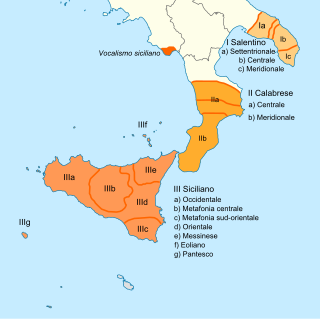
The Extreme Southern Italian dialects are a set of languages spoken in Salento, Calabria, Sicily and southern Cilento with common phonetic and syntactic characteristics such as to constitute a single group. These languages derive, without exception, from Vulgar Latin but not from Tuscan; therefore it follows that the name "Italian" is a purely geographical reference.















